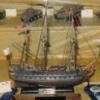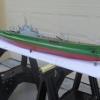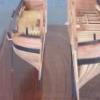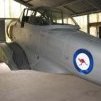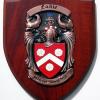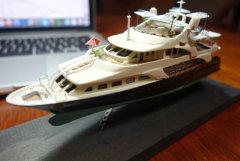MORE HANDBOOKS ARE ON THEIR WAY! We will let you know when they get here.
×
-
Posts
559 -
Joined
-
Last visited
Reputation Activity
-
 ScottRC reacted to KeithAug in Endeavour 1934 by Julie Mo - Amati - Scale 1:35 - America's Cup UK J-Class Challenger
ScottRC reacted to KeithAug in Endeavour 1934 by Julie Mo - Amati - Scale 1:35 - America's Cup UK J-Class Challenger
Julie
Re clinker effect.
If you try to bow a plank in 2 directions at once (i.e bow in the weak and strong direction) the wood tries to deal with the stress by twisting. This causes one corner to press in to the backing. In my case the upper edge was trying to dig into the backing. The zoom on the photograph and the sanding exaggerates the effect. In fact the step between planks was at worst about 1/3 of the plank width. The only way to eliminate the clinker is to taper the planks and by doing so only have bending across the weak direction. Of course tapering takes a lot more time. On previous builds with more complex hull shapes I have tapered the planks. With Endeavour I felt the lines were fine enough to get away without tapering albeit at the expense of sanding about 1/3 of the 1st planking away in some areas. I wouldn't however have used parallel planks if I hadn't backed with balsa.
The good news however is that the 2nd planks bing very thin bend very easily and in consequence exhibit no tendency to clinker.
I like your wedge approach to straightening. Did you do the wedge cut outs on both sides before installing the wedges in the 1st side (important as the compressive strength on the 2nd side will be high without the wedge cut outs).
Keith
-
 ScottRC reacted to Julie Mo in Endeavour 1934 by Julie Mo - Amati - Scale 1:35 - America's Cup UK J-Class Challenger
ScottRC reacted to Julie Mo in Endeavour 1934 by Julie Mo - Amati - Scale 1:35 - America's Cup UK J-Class Challenger
I began putting her nose back where it belonged...
Being parallel to the straight edge is the goal. The two wedges on the left are cedar, the other four are balsa. The tip moved a bit closer but it's still off. I am surprised how much resistance there is to making it straight.
Another realization came about when I tried to work on the deck. Now that the backing is in, there is no place for those Bessey clamps to hold the hull without denting the backing. I'll probably wait until I get my shop set up before building a proper cradle.
-
 ScottRC got a reaction from Piet in Cutty Sark by NenadM
ScottRC got a reaction from Piet in Cutty Sark by NenadM
The deck house looks great Nenad. You doing this makes me feel more confident in scratch building the deck houses when I build my Seawitch.
-
 ScottRC got a reaction from dgbot in Cutty Sark by NenadM
ScottRC got a reaction from dgbot in Cutty Sark by NenadM
The deck house looks great Nenad. You doing this makes me feel more confident in scratch building the deck houses when I build my Seawitch.
-
 ScottRC got a reaction from PeteB in Endeavour 1934 by Julie Mo - Amati - Scale 1:35 - America's Cup UK J-Class Challenger
ScottRC got a reaction from PeteB in Endeavour 1934 by Julie Mo - Amati - Scale 1:35 - America's Cup UK J-Class Challenger
Hi Julie,
I just came across your build and also visited your website and wanted to say that you are a very talented and experienced woodworker. You fit right in with the other extremely talented craftsmen here at MSW and we are glad you have joined us. This place is great in that no matter what level of builder or what medium you build in, we seem to treat each other as equal. I really am enjoying this build log and how you are dealing with working without the comfort of your professional workshop. Keith and the others are a wealth of information. We hope all goes well with getting into the new "digs" and trying to get your new studio set up.
As far as finish, I agree, it needs to be natural. A built up frame is such a beauty to look at in its natural state that at times I hate to move on and finish it. If I was to build a J class and paint it, then I would have built a plug and made it out of fiberglass.
The subject of tools, we progress with the quality of tool as we progress with experience and drive to perfect our trade. As you have obtained a higher level of proficiency in wood working, you have honed your skills and your hands expect the feel and accuracy of a good quality tool. S.Coleman is correct, its from the hands of a skilled user of a quality tool that produces fine work, not the tool.
Scott
-
 ScottRC got a reaction from mtaylor in Cutty Sark by NenadM
ScottRC got a reaction from mtaylor in Cutty Sark by NenadM
The deck house looks great Nenad. You doing this makes me feel more confident in scratch building the deck houses when I build my Seawitch.
-
 ScottRC got a reaction from GLakie in Cutty Sark by NenadM
ScottRC got a reaction from GLakie in Cutty Sark by NenadM
The deck house looks great Nenad. You doing this makes me feel more confident in scratch building the deck houses when I build my Seawitch.
-
 ScottRC got a reaction from Omega1234 in Cutty Sark by NenadM
ScottRC got a reaction from Omega1234 in Cutty Sark by NenadM
The deck house looks great Nenad. You doing this makes me feel more confident in scratch building the deck houses when I build my Seawitch.
-
 ScottRC got a reaction from NenadM in Cutty Sark by NenadM
ScottRC got a reaction from NenadM in Cutty Sark by NenadM
The deck house looks great Nenad. You doing this makes me feel more confident in scratch building the deck houses when I build my Seawitch.
-

-
 ScottRC reacted to NenadM in Cutty Sark by NenadM
ScottRC reacted to NenadM in Cutty Sark by NenadM
Thank you Piet. I`ll try to make surrounding surface thicker, making a new surface from veneer to overcome existing roof about 1 mm on each side, on which I`ll glue windows, and add some strips of veneer around windows and at the edge. That will allow me to round edges of surface a bit as on picture, and to level them visually to roof. I have already thinned whole windows construction to less than a 1 mm, and don`t dare to thin them more
Little improvement to my shipyard
I was borred from filling, repairing and repainting scarps cuts and holes on the workbench in front of me, find this for 5€ in toy store hidden between Revell models, and bye it
-
 ScottRC reacted to NenadM in Cutty Sark by NenadM
ScottRC reacted to NenadM in Cutty Sark by NenadM
Thanks Nils and likes.
Looking at picture of skylight ... thinking ... pathetic try ... how to make to look as this:
brain-storm hit me, and here is final test
If anybody is interested, step by step instructions are posted there
http://modelshipworld.com/index.php/topic/4679-the-kit-bashers-guide-to-the-galaxy/#entry134594
And a new appearance of shipmodeling laws: More tricky detail, more times to repeat. Six windows on skylight to go
-
 ScottRC reacted to KeithAug in Endeavour 1934 by Julie Mo - Amati - Scale 1:35 - America's Cup UK J-Class Challenger
ScottRC reacted to KeithAug in Endeavour 1934 by Julie Mo - Amati - Scale 1:35 - America's Cup UK J-Class Challenger
Hi Julie
I applied glue to the hull for the entire length of the plank so that the back of the plank and the edge of the plank abutting the previous plank was glued. I didn't size the balsa. Not sure if the glue shrank the balsa - I didn't notice it doing this. I did secure the planks quite well during gluing so they were pressed hard against the backing and the previous plank- see photo.
if you have distortion in the hull it may reveal itself when you are planking the deck - mismatch between deck planks on either side (which I always think is very irritating on the eye). Better to correct it now.
-
 ScottRC reacted to Landlocked123 in Endeavour 1934 by Julie Mo - Amati - Scale 1:35 - America's Cup UK J-Class Challenger
ScottRC reacted to Landlocked123 in Endeavour 1934 by Julie Mo - Amati - Scale 1:35 - America's Cup UK J-Class Challenger
Hi Jules,
As you know, I've been lurking around since your first posts on MSW. My only question is between building and posting when exactly do you sleep?
Best,
John
-
 ScottRC reacted to Julie Mo in Endeavour 1934 by Julie Mo - Amati - Scale 1:35 - America's Cup UK J-Class Challenger
ScottRC reacted to Julie Mo in Endeavour 1934 by Julie Mo - Amati - Scale 1:35 - America's Cup UK J-Class Challenger
Keith, again, thanks for your input. The pictures are very timely and helping a lot.
With the backing you did, I was surprised to see sanding the first planking revealed the places where the frames are were high. Did you apply glue to the entire length of all the 1st planks? I'm wondering if you did, did the glue shrink the balsa.
I've been thinking of glue sizing to seal the wood before doing the final sanding. If my memory serves me correctly, when gluing very porous woods or end grain, you apply some glue sizing, let it dry then do the glue up. Some of the balsa lifts instead of sanding smooth. Adding sizing would cure this.
I am a believer in throw the most time in prop work and everything is easier after that.
Per, thanks for the compliment! It's interesting to see another modeler is having issues with following the Amati directions exactly. I see other models that have frames much closer than this model. At first, it looked like overkill. But now I really understand why additional frames are necessary. I'm learning!
Now, I have another question...
When I took the model out of the Bessey clamps and flipped it over, I noticed the tip of the bow went askew. I had been eyeing a straight edge as I did the backing but I obviously missed the dog in the bow. I am guessing I need to fix that, right?
-
 ScottRC reacted to Nirvana in Endeavour 1934 by Julie Mo - Amati - Scale 1:35 - America's Cup UK J-Class Challenger
ScottRC reacted to Nirvana in Endeavour 1934 by Julie Mo - Amati - Scale 1:35 - America's Cup UK J-Class Challenger
Hi Julie,
I just finished reading through your build log and you have done the right choice of backing between the bulkhead.
You will find the planking easier but also due to the distance of the bulkheads, just regular planking can make the build an even worse headache.
A friend of mine is building the same yacht without the backing and has issues, because the planking is getting extremely thin when sanding.
Your persistence will pay off!
Very nice job by the way!
-
 ScottRC reacted to KeithAug in Endeavour 1934 by Julie Mo - Amati - Scale 1:35 - America's Cup UK J-Class Challenger
ScottRC reacted to KeithAug in Endeavour 1934 by Julie Mo - Amati - Scale 1:35 - America's Cup UK J-Class Challenger
Hi Julie
You still seems to be going well. like you I find rubbing the palm of a hand over the surface to be a good method of checking the shape.
Because the balsa sands away more quickly than the frames it is very difficult to avoid some flattening of the profile between frames. Slight flattening isn't however a significant problem as it tends to be compensated by the 1st planking. In the attached photo I have done a light sanding of the 1st planked hull - you can see the areas where the frames have caused the planks to be raised. As sanding proceeds these raised areas are removed - see 2nd photo.
Like you I found the rudder wasn't the correct shape at its upper end. Also the plans show a weird discontinuity between the rudder and hull at the base of the rudder - I ignored the plans in this instance.
The instructions don't seem to cover what you do about finishing the rudder. Have you decided what you are going to do?
Keith
-
 ScottRC reacted to robnbill in Endeavour 1934 by Julie Mo - Amati - Scale 1:35 - America's Cup UK J-Class Challenger
ScottRC reacted to robnbill in Endeavour 1934 by Julie Mo - Amati - Scale 1:35 - America's Cup UK J-Class Challenger
Julie, once you think your ready, you can take black pinstripe tape and run along a line of the hull (or use a thin strip of wood). this will show you any dips in the hull.
-
 ScottRC reacted to Julie Mo in Endeavour 1934 by Julie Mo - Amati - Scale 1:35 - America's Cup UK J-Class Challenger
ScottRC reacted to Julie Mo in Endeavour 1934 by Julie Mo - Amati - Scale 1:35 - America's Cup UK J-Class Challenger
Thank you for the support guys. Maybe I give too much credit to the tools, but they are better than the ones they replaced.
Moving day is only ten days away but there isn't much we have to move from this rental so I'm choosing to procrastinate on the packing and see if I can get the model done to at least plank-ready.
I did finish the balsa backing (finally!) and took to the fairing. Maybe it was my impatience but it sees getting down to that last few fractions takes forever. My goal is to leave a thin bead of laser burn on the frame edges. That way I know the hull is properly faired.
When I got to the keel, I found the mahogany sides of the centerboard assembly protruded beyond the adjoining frames. So I took a small rasp and worked the balsa down to meet the frames.
The fairing didn't go as I had hoped. Certain areas sanded down to the frames quickly while other areas proved stubborn. You can see which is which by looking at the laser burn that remains. I'll work those until I get that thin burn line I'm going for. I am using my hands a lot to check for waves and high and low spots. Before I start the planking, I'll shoot a light across the surface and finish up that way.
When I went to fit the rudder, I found I needed to do some filing on the frame before it would fit. I'm still toying with the idea of making it pivot. To accomplish that. there will have to be some careful profiling of the plywood rudder and I will have to beef up the bottom pivot point a bit.
I really don't see how I could have relied solely on the frames to begin planking. There's too much room for buckling and bowing. And then you'd have to fair that. I can see why some modelers have talked about the fear of sanding through the first planking. I'm glad I did the backing. And next time I'll know how to make the work flow better.
-
 ScottRC got a reaction from Piet in Young America 1853 by EdT - FINISHED - extreme clipper
ScottRC got a reaction from Piet in Young America 1853 by EdT - FINISHED - extreme clipper
Ed, again, thank you for giving us such a wonderful tutorial on how you do such craftsmanship.
-
 ScottRC got a reaction from Eddie in Endeavour 1934 by Julie Mo - Amati - Scale 1:35 - America's Cup UK J-Class Challenger
ScottRC got a reaction from Eddie in Endeavour 1934 by Julie Mo - Amati - Scale 1:35 - America's Cup UK J-Class Challenger
Hi Julie,
I just came across your build and also visited your website and wanted to say that you are a very talented and experienced woodworker. You fit right in with the other extremely talented craftsmen here at MSW and we are glad you have joined us. This place is great in that no matter what level of builder or what medium you build in, we seem to treat each other as equal. I really am enjoying this build log and how you are dealing with working without the comfort of your professional workshop. Keith and the others are a wealth of information. We hope all goes well with getting into the new "digs" and trying to get your new studio set up.
As far as finish, I agree, it needs to be natural. A built up frame is such a beauty to look at in its natural state that at times I hate to move on and finish it. If I was to build a J class and paint it, then I would have built a plug and made it out of fiberglass.
The subject of tools, we progress with the quality of tool as we progress with experience and drive to perfect our trade. As you have obtained a higher level of proficiency in wood working, you have honed your skills and your hands expect the feel and accuracy of a good quality tool. S.Coleman is correct, its from the hands of a skilled user of a quality tool that produces fine work, not the tool.
Scott
-
 ScottRC got a reaction from Canute in Endeavour 1934 by Julie Mo - Amati - Scale 1:35 - America's Cup UK J-Class Challenger
ScottRC got a reaction from Canute in Endeavour 1934 by Julie Mo - Amati - Scale 1:35 - America's Cup UK J-Class Challenger
Hi Julie,
I just came across your build and also visited your website and wanted to say that you are a very talented and experienced woodworker. You fit right in with the other extremely talented craftsmen here at MSW and we are glad you have joined us. This place is great in that no matter what level of builder or what medium you build in, we seem to treat each other as equal. I really am enjoying this build log and how you are dealing with working without the comfort of your professional workshop. Keith and the others are a wealth of information. We hope all goes well with getting into the new "digs" and trying to get your new studio set up.
As far as finish, I agree, it needs to be natural. A built up frame is such a beauty to look at in its natural state that at times I hate to move on and finish it. If I was to build a J class and paint it, then I would have built a plug and made it out of fiberglass.
The subject of tools, we progress with the quality of tool as we progress with experience and drive to perfect our trade. As you have obtained a higher level of proficiency in wood working, you have honed your skills and your hands expect the feel and accuracy of a good quality tool. S.Coleman is correct, its from the hands of a skilled user of a quality tool that produces fine work, not the tool.
Scott
-
 ScottRC got a reaction from dgbot in Endeavour 1934 by Julie Mo - Amati - Scale 1:35 - America's Cup UK J-Class Challenger
ScottRC got a reaction from dgbot in Endeavour 1934 by Julie Mo - Amati - Scale 1:35 - America's Cup UK J-Class Challenger
Hi Julie,
I just came across your build and also visited your website and wanted to say that you are a very talented and experienced woodworker. You fit right in with the other extremely talented craftsmen here at MSW and we are glad you have joined us. This place is great in that no matter what level of builder or what medium you build in, we seem to treat each other as equal. I really am enjoying this build log and how you are dealing with working without the comfort of your professional workshop. Keith and the others are a wealth of information. We hope all goes well with getting into the new "digs" and trying to get your new studio set up.
As far as finish, I agree, it needs to be natural. A built up frame is such a beauty to look at in its natural state that at times I hate to move on and finish it. If I was to build a J class and paint it, then I would have built a plug and made it out of fiberglass.
The subject of tools, we progress with the quality of tool as we progress with experience and drive to perfect our trade. As you have obtained a higher level of proficiency in wood working, you have honed your skills and your hands expect the feel and accuracy of a good quality tool. S.Coleman is correct, its from the hands of a skilled user of a quality tool that produces fine work, not the tool.
Scott
-
 ScottRC reacted to JRB9019 in HM Schooner Pickle by JRB9019 - Caldercraft - Scale 1:64
ScottRC reacted to JRB9019 in HM Schooner Pickle by JRB9019 - Caldercraft - Scale 1:64
Pintles and Gudgeons
So, I finally have the rudder more or less completed, and for now, another step acomplished. When I read Blue-Ensign's comments "An afternoons work to secure these, a little fiddly getting the pintles and gudgeons to meet up" I knew there were interesting times ahead.
First step was to fit the Pintles to the Rudder - hey, at least I got it the right way round - progress indeed.
Hmmm, trying to centre the straps was quite fiddly so I had the idea of drilling a pilot hole in the percieved currect place, then using a dome-head pin to keep the straps more or less in the right place before starting to glue them down.
Great idea....... if you're an octopus - I'm not, so resorted to my 'helping-hand' to help me out.... that worked well.
A word of warning. As the strap's centre now has a hole drilled through it, it makes the strap very delicate indeed. On my first strap, I managed to glue the first side to the rudder OK, but as I bent the second side........... it snapped. Not too much of an issue as I could simply glue the part on - and the join can't be seen.... Note to self, "I must be more careful".....
I finished the straps the carefully drilled the holes out to accept the pins which by now were shortened and bent to the correct 90 Degree angle. Trouble was, I then realised that the downward pin section was too long and if I had fitted it I wouldn't be able to hook it to the Gudgeon later on. Luckily I hadn't glued in the pin so pulled it out and did a little snipping .......... and of course dropped the pin into the black void that surrounds the modeller, never to be seen again.
Three pins later, I got it about right (so I thought) and finished off the rudder.
Then as per instructions, I positioned the rudder and, using masking tape, fixed the rudder in place. I then worked out where to fit the Gudgeon straps and marked up accordingly.
Off with the rudder, drilled the holes, added the Gudgeon pins, removed the pins and messed around for a while as I glued the straps and Gudgeons in place.
And there you have it (sort of).
The beedy eyed ones among you will possibly (how could you not!!) notice that the top Gudgeon doesn't line up correctly and that I seem to have made the Pintels just a little too short. Still, it's too late now as everything is glued into place.
I will be adding rudder chains, 'leather' covers deck-side and below the Transom and finally 'metal support straps' to the tiller arm when I make the final fit in due course. I'm sure that my Rudder chains will distract from the imperfection......... that will be a "Yes of course it will" then!!
Next, it's time to drill various holes around the ship and add various eyelets, gammoning rings and the like..
-
 ScottRC reacted to JRB9019 in HM Schooner Pickle by JRB9019 - Caldercraft - Scale 1:64
ScottRC reacted to JRB9019 in HM Schooner Pickle by JRB9019 - Caldercraft - Scale 1:64
Thanks Rick
Always glad to be of service!
I've just finished adding the Pintles, Gudgeons and straps to the rudder - wow, that was fun!!
My rudder now hangs unaided, so something must be right!!
I will post some photo's later today.
All I can say is - read the instructions VERY carefully - follow them EXACTLY and you should be fine.
John


